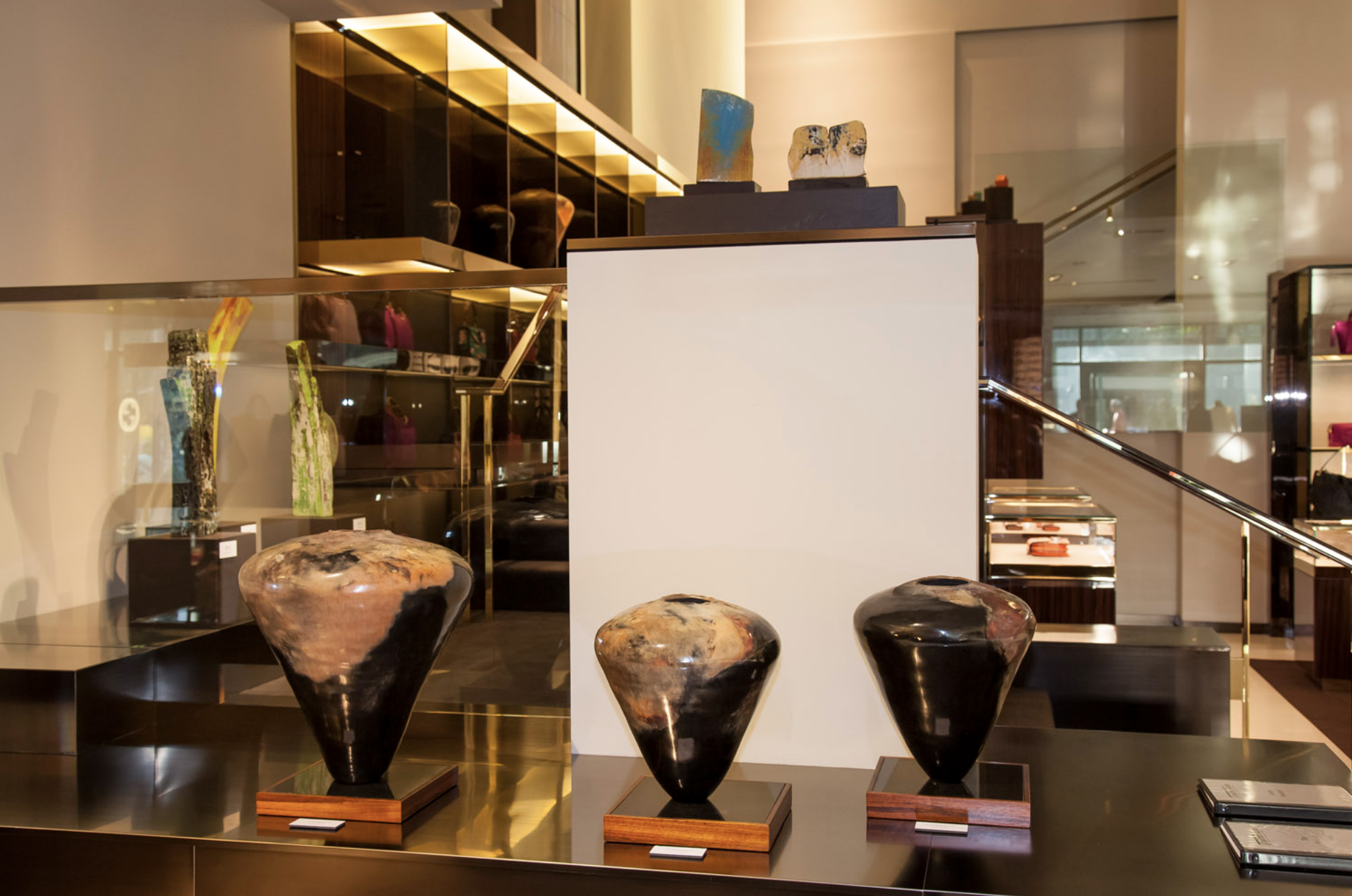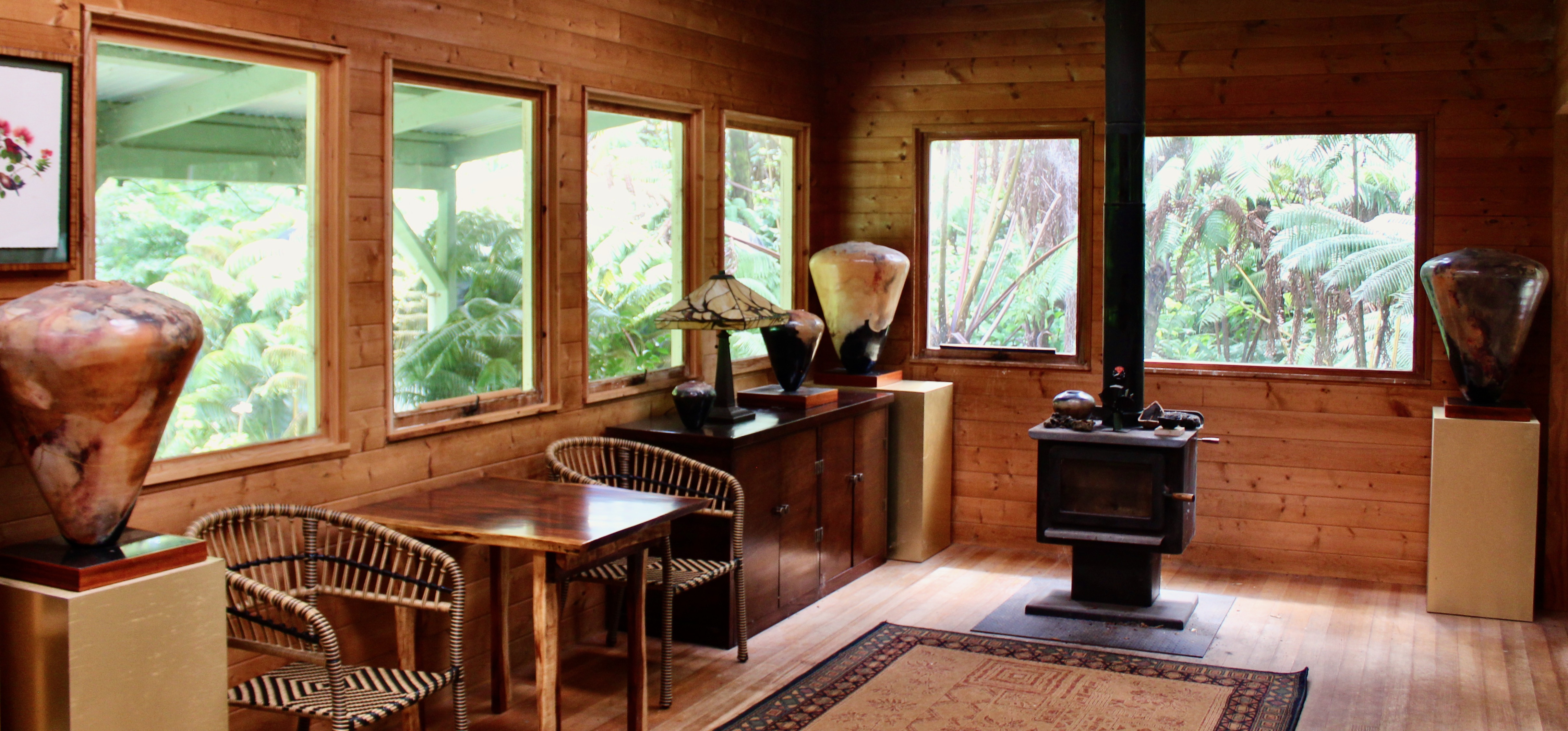
Pit-Fired Ceramic Volcanic Vessels
Living on the Edge
.jpeg)
These vessels are inspired by the experience of living in close proximity to a most extraordinary place near the summit of Kīlauea volcano on the Big Island of Hawaiʻi. The inner crater within the summit caldera of Kīlauea is known as "Halemaʻumaʻu," which means "house of the ʻāmaʻu fern," and this designates the home or abode of Pele, the Hawaiian volcano goddess. The house where I now live is nestled into an almost pristine native Hawaiian forest only a couple of miles from the edge of the abode of Pele. The house was built by Albert Saijo, one of the beat poets, and in the closing lines of his book OUTSPEAKS: A RHAPSODY, he explains how he and his wife came to live on the edge of the volcano.
BY AN ODD LEGERDEMAIN OF FATE WE ARE TRANSPORTED TO A SMALL CLEARING IN AN UPLAND ‘ŌHI‘A LEHUA HĀPU‘U FOREST AT 4000' EDGING AN ACTIVE VOLCANO – ANOTHER EDGE – LIKE THEY SAY IF YER NOT LIVIN ON THE EDGE YER TAKIN UP TOO MUCH SPACEAlbert Saijo, OUTSPEAKS: A RHAPSODY, 199.
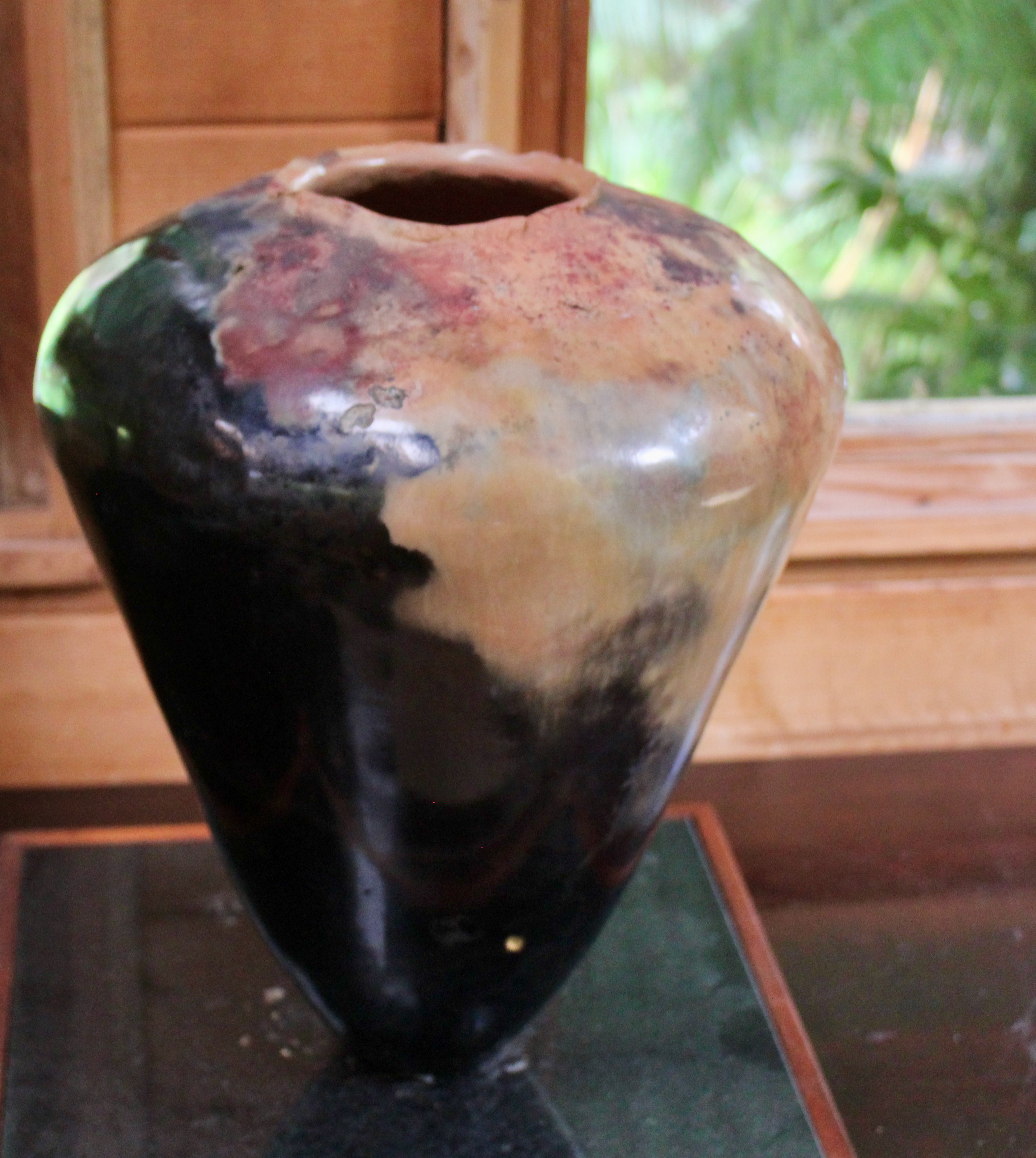
The quote Saijo ends with has been attributed to various sources, but the basic idea expresses something similar to Nietzsche’s famous line that the secret to life is to live dangerously on the slopes of a volcano. For both the poet and the philosopher it is not a time to rest content as our modern civilization seems headed inexorably toward catastrophe. If it isn’t through global conflict and nuclear war, environmental degradation and climate change could bring about the end of civilization and our life on earth.
For believe me: the secret for harvesting from existence the greatest fruitfulness and the greatest enjoyment is—to live dangerously! Build your cities on the slopes of Vesuvius!Friedrich Nietzsche,The Joyous Science, §283
In Hawaiian culture it is emphasized that one should approach the abode of Pele with reverence. I cannot claim to understand the depths of the Hawaiian understanding of Pele; but I can relate that I have stood on the edge of Halemaʻumaʻu a few times and looked down into the glowing lake with its golden fountains and rivers of lava and have certainly come to appreciate that call for reverence in approaching the abode of Pele. Hawaiians have long understood that the islands themselves, the ʻĀina, or land upon which they lived and from which they drew sustenance, came from that fiery force that poured forth from the summit and slopes of the volcano.

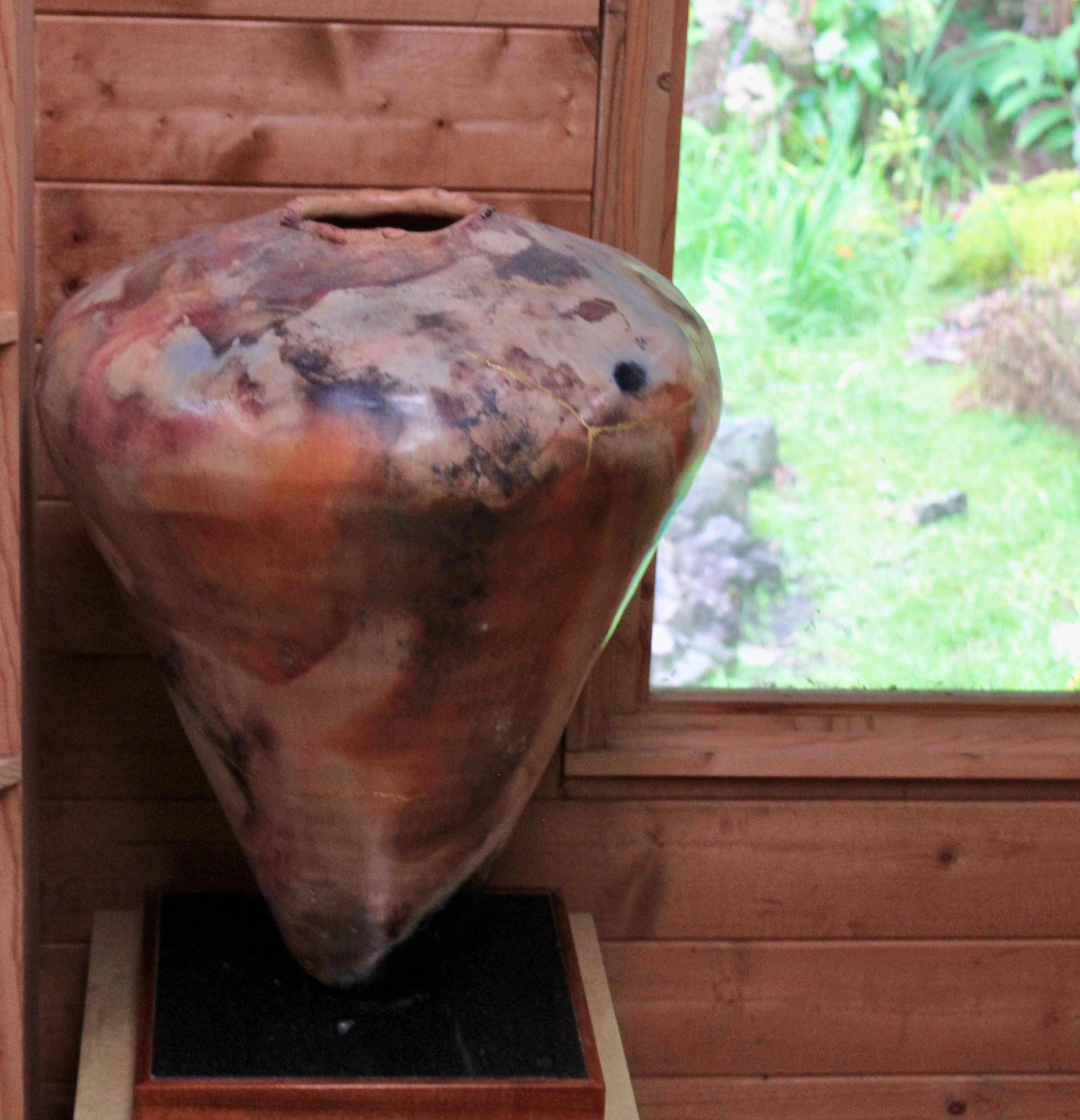
They also well understood that Pele not only gave birth to the ʻĀina and the life that flourished, she could also bring sudden destruction and death in her wrathful eruptions. The creative and destructive power of Pele, recounted in Hawaiian stories and chants from times ancient to the present, was on full display for all to see in the great eruption during the summer of 2018. While the summit region was rocked by constant earthquakes and explosions from Halemaʻumaʻu, massive fountains and rivers of lava poured out far down below in the Puna district destroying over 750 homes and adding acres of land along the coast.
When one stands on the edge of Halemaʻumaʻu and looks down into the molten lake of lava one is looking at the top of a magma plume that rises up from the deepest depths of the earth. Now we know that it is the movement of magma around the iron core that creates the magnetic field that protects the earth’s atmosphere from being blown away by the solar winds. If one understands this, then one might appreciate that one of the things that makes life on earth possible at all is this fire within the earth, shown here lighting up Pele's abode looking down from the slopes of Mauna Loa on a dark, cold night beneath Jupiter and a canopy of stars.
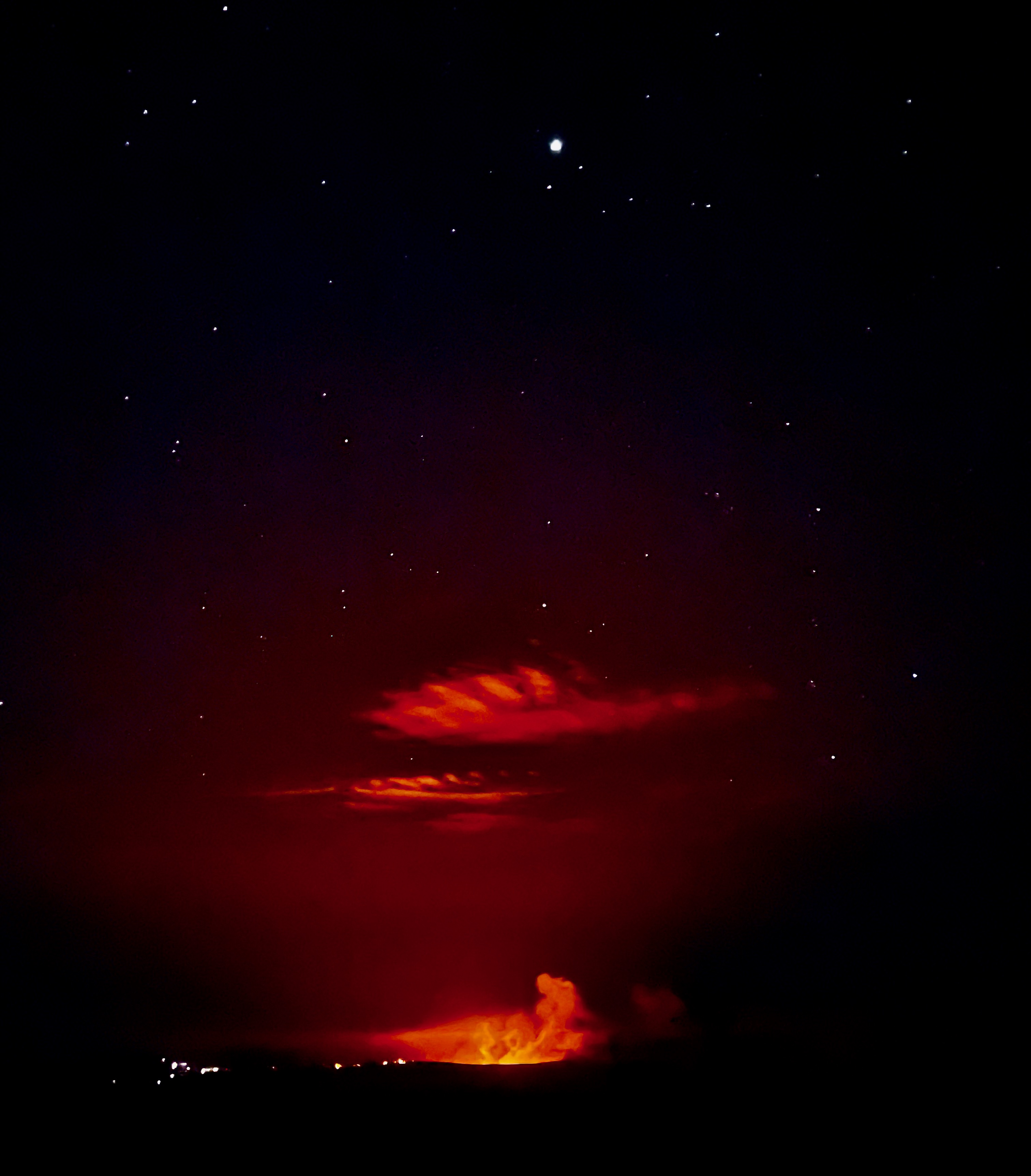
Perhaps we do have something to learn from Hawaiian culture, from the close kinship relationship Hawaiians have with the ʻĀina, the sacredness of such extraordinary places such as the abode of Pele, and the message carried around the world in the Mālama Honua Worldwide Voyage of the Hōkūleʻa. I think the Hōkūleʻa is just an important symbol today as the grey lady in New York harbor, perhaps even more important when one considers how the notion of 'liberty' has been used these days to glorify the most wanton greed and selfishness.
My pit-fired volcanic vessels evoke the volcano landscape and are an attempt to honor or show reverence for the abode of Pele (Hoʻohanohano i ka Hale o Pele).
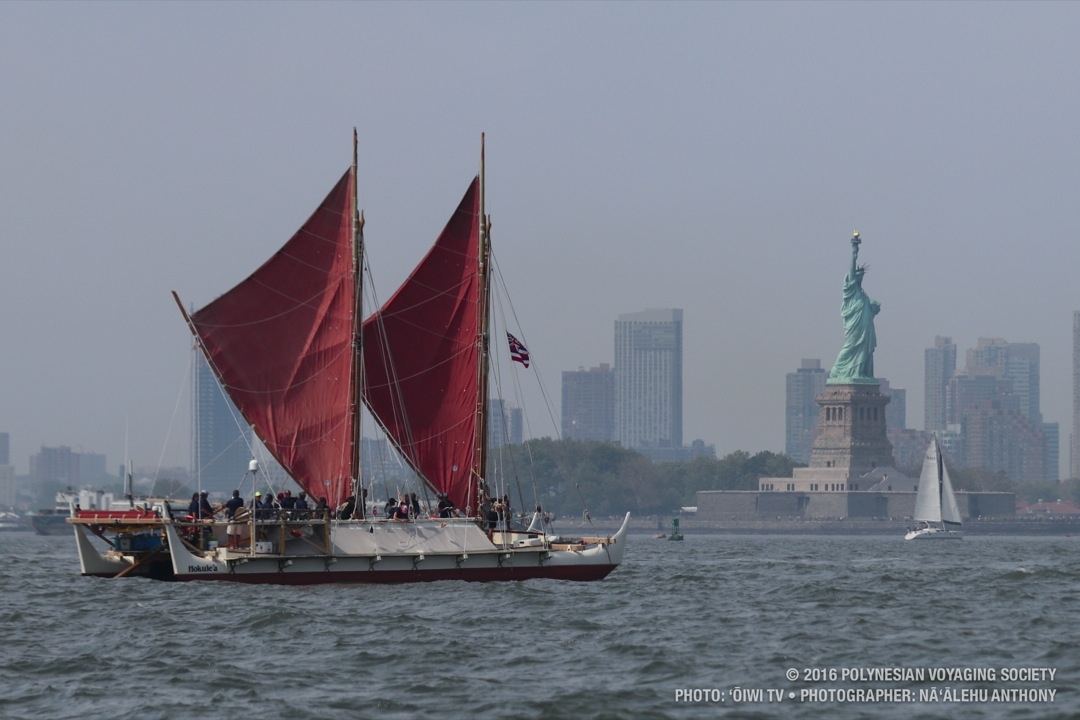
The Hawaiian name for this voyage, Mālama Honua, means “to care for our Earth.” Living on an island chain teaches us that our natural world is a gift with limits and that we must carefully steward this gift if we are to survive together. As we work to protect cultural and environmental resources for our children’s future, our Pacific voyaging traditions teach us to venture beyond the horizon to connect and learn with others. The Worldwide Voyage is a means by which we now engage all of Island Earth—bridging traditional and new technologies to live sustainably, while sharing, learning, creating global relationships, and discovering the wonders of this precious place we all call home.The Polynesian Voyaging Society
Throwing/Shaping the Vessels

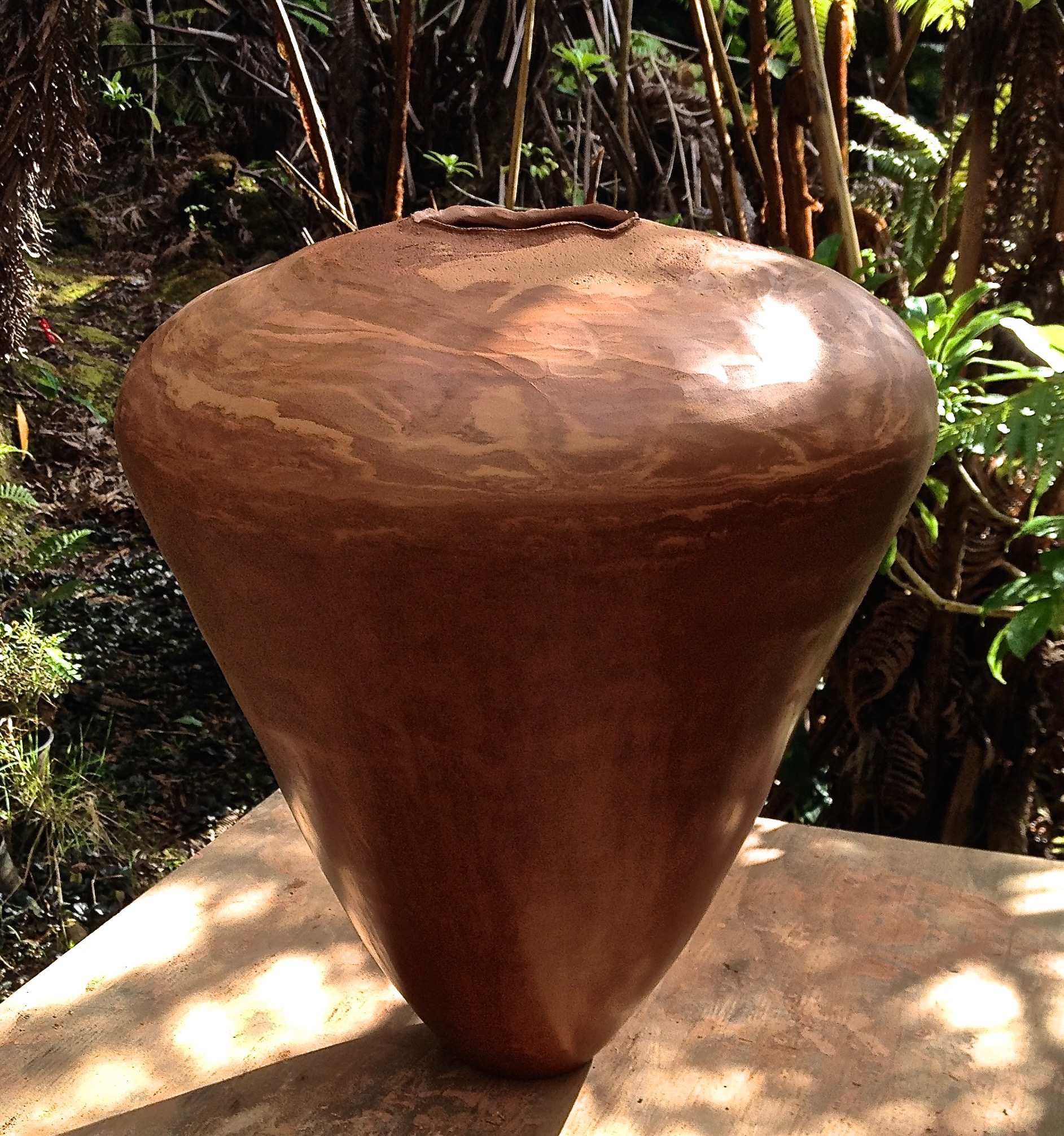
The vessels are made in a very unusual manner. A closed form is first thrown on the wheel, and then, after drying a bit, is turned over and opened from what was formerly the base. When I open the closed form from what was formerly the base, I push the clay upwards from the inside to gradually form the shape of the top of the vessel. I am careful not to touch the outside surface at the top of the vessel, leaving this surface untouched by the hand. Sometimes this surface will split and crack as it is pushed up from within and leaving this untouched evokes the fractured volcano landscape.This is an effect that one just cannot get in a traditionally thrown vessel.
Burnishing the Vessels

There are no glazes on these vessels as glazes cannot be used in a pit-fire. The fire does not get hot enough to melt a glaze, and the ash fall would ruin a glaze even if it could melt. The glazed appearance of these vessels is the result of a patient burnishing process in which the raw clay is burnished with a polished stone until it comes to a polished stone finish. This starts when the clay is ‘leather-hard,’ when the vessel has dried enough to hold its shape but still soft enough to start smoothing the surface with the stone. After it dries a little more it must be burnished again, and then again several times more through the drying process. When the piece is bone-dry, then some olive oil is rubbed over the surface and the clay is burnished once again, finally coming to the lustrous glazed appearance of these vessels. During this burnishing process I am always careful to leave the rough and sometimes fractured surfaces around the opening untouched. One of the striking features of the vessels is this raw untouched surface around the opening, a feature which could not be achieved in a traditionally thrown vessel.
Firing the Vessels
The pit-firing process is one of the oldest methods of firing clay. While at the Louvre in Paris in the summer of 2015, I saw these beautiful Egyptian tulip-shaped cups. They were burnished and pit-fired, and although 5000 years old, they looked like they could have come from one of my recent fires.
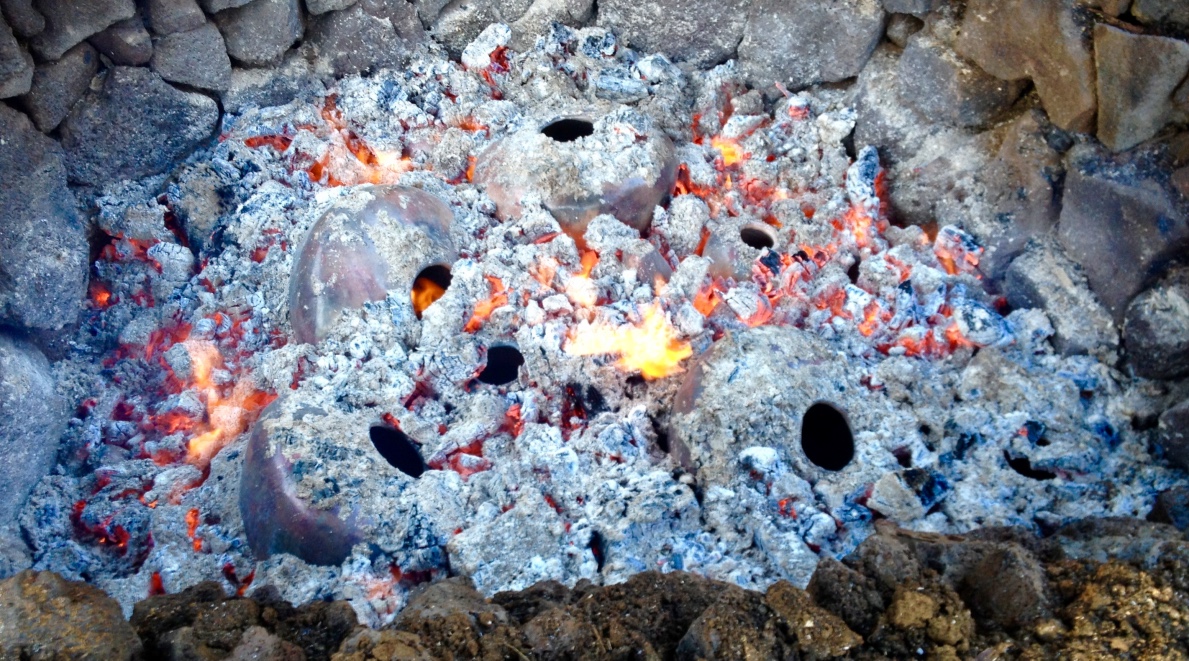
After bisque firing the vessels are embedded in sawdust at the base of a pit. Wood is then carefully stacked on top and then set afire. Where they are embedded in sawdust the vessels turn black, with sometimes beautiful iridescent effects. The colors in the clay come out where the vessel is exposed to the fire. The deep red color comes from sprinkling powdered copper carbonate on the vessel before the wood is placed on top.
Featured Exhibitions

The Sacred Earth, 2021. Pit-fired ceramic, 11¾” x 10” x 10”.
Art & Anarchy 2021
Hale Ho‘omana Varez Hall
Niaulani Campus
Volcano Art Center
September 10—October 1, 2021
Catalogue
On this particular vessel, I covered the top before opening it with a thick slip which included some ash and reticulite from the 2018 eruption. After drying a bit, the slip was coated with a thin wash of sodium silicate; and thus, when it was opened the surface cracked dramatically, heightening this evocation of the volcano landscape.

1st Annual Contemporary Craft Exhibition
Hawai‘i Island Art Alliance,
Wailoa Center, Hilo, Hawai‘i, September 2-29, 2016.
*First Place Ceramics*
The Vessels were featured in the
10th Annual Celebration of the Arts
Hawaii's Modern Masters
Luxury Row Waikiki
November 5 — December 1, 2015

Minimenta:
La grand exposition des petits formats.
Galerie Goutte de Terre,
Paris, France.
June 11-27, 2015.
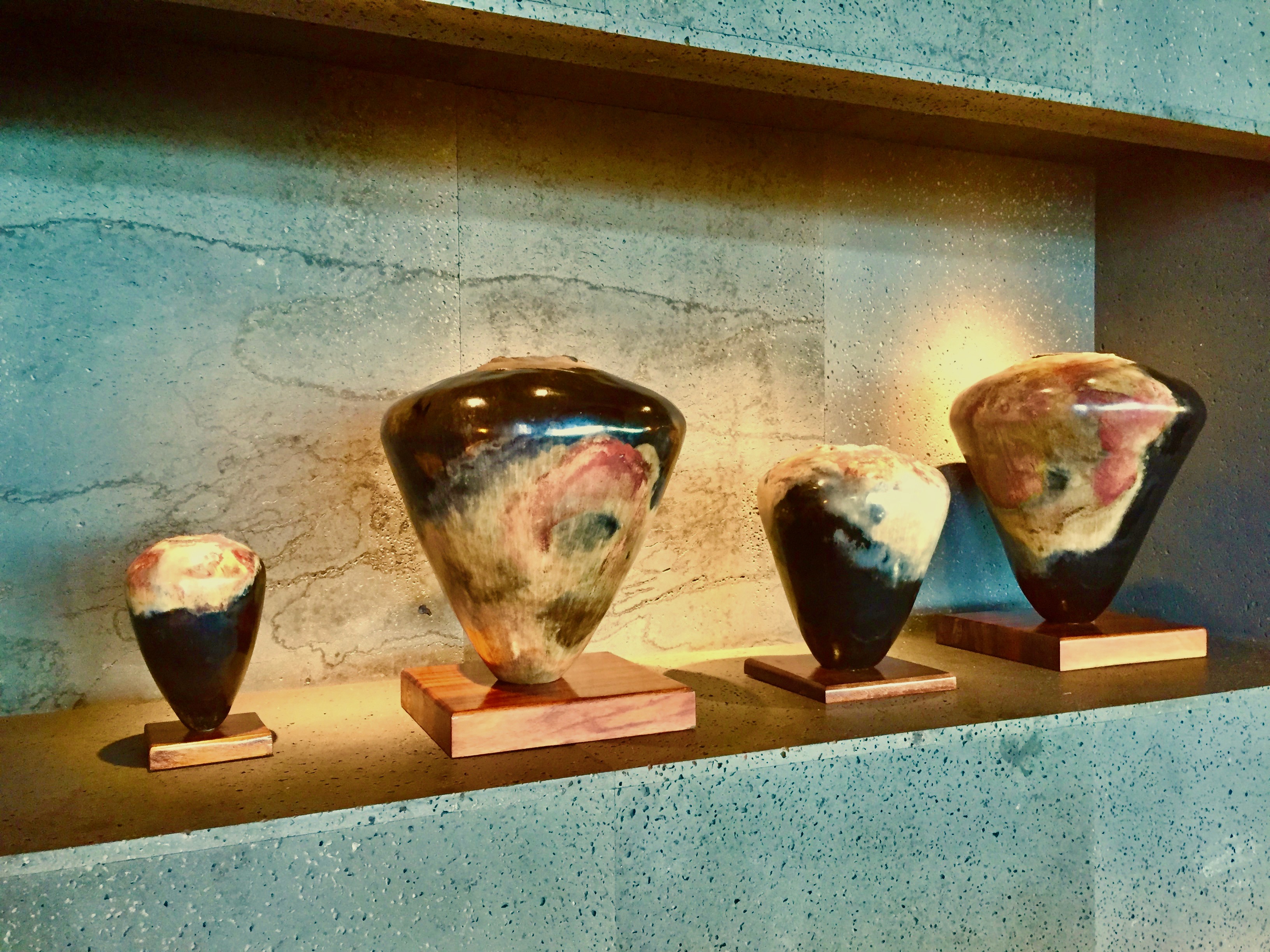
Kohanaiki Resort
Summer 2015
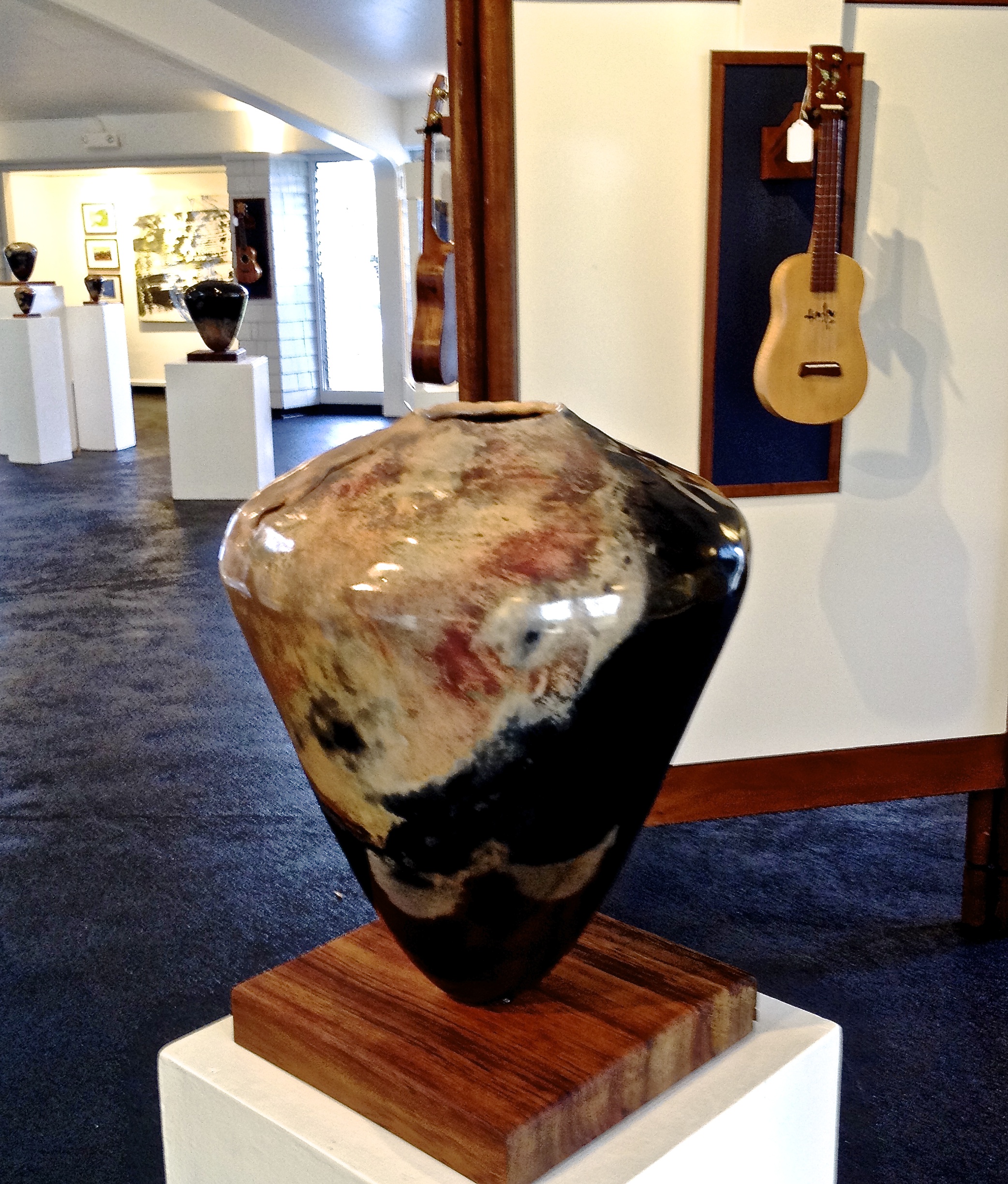
9th Annual Artist Invitational: Wood, Paintings, Clay
Wailoa Center,
Hilo, Hawai‘i.
October 3-30, 2014
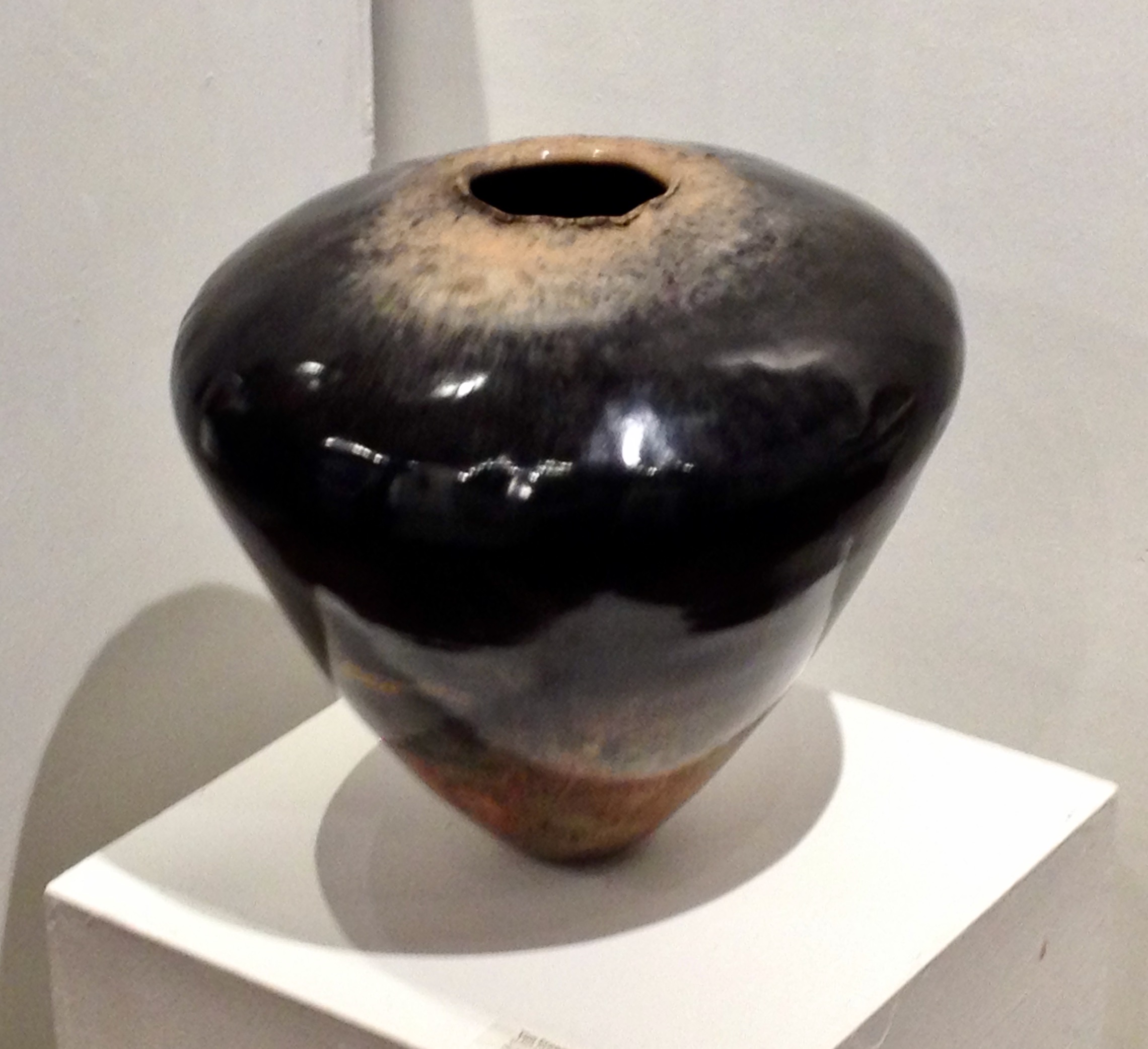
Where Earth Meets Fire:
Contemporary Ceramics on the Big Island
Donkey Mill Art Center,
Holualoa, Hawai‘i.
September 6 - October 31, 2014.
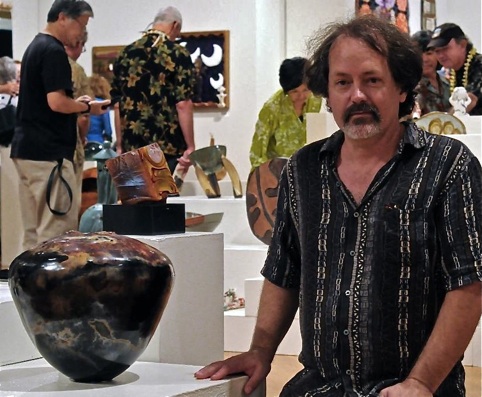
Hawai‘i Craftsmen's
45th Annual Statewide Juried Exhibition
Honolulu Academy Art Center,
Honolulu, Hawai‘i,
August 30 - September 20, 2012

Artists of Hawai‘i 2011
Honolulu Art Academy,
Honolulu, Hawai‘i,
June 30 - September 25, 2011.

Volcano Art Center
